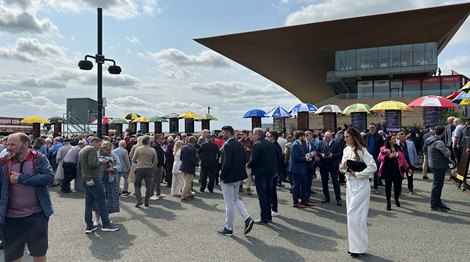The experience of this year’s Irish Derby (G1) day June 30 at the Curragh as well as the continued flat performance of pari-mutuel wagering in North America has only reinforced my belief that racing is missing out on its best chance in years to bring new people into the sport by not fully embracing fixed-odds wagering.
Let me explain.
I was fortunate enough to spend a vacation day as a fan at Ireland’s big race day, and as I ventured into the area beside the parade ring where the bookmakers are based, it was quite a thrill to shop around for the best price on the horses I liked. And the representatives of the bookmakers did their best to let fans know of those prices, quickly realizing if they were offering the best price on one of the favorites and shouting out that information to the masses.
An odds point here or half-point there just brings a bit of satisfaction to the handicapping process. If you’re not a horseplayer, it’s similar to the feeling of finding a better price on a product on sale that you already wanted. In fixed-odds wagering, the odds are set at the time a ticket is purchased. In pari-mutuel wagering, the odds fluctuate until a pool is completely settled—typically when the gates open, which means that the final tabulation of that pool isn’t available until after the race has started.
I should mention that the pari-mutuel wagering offered on-site June 30 at the Curragh, into the World Pool, also offered some exciting opportunities. The point is: It was nice to have a choice.
I couldn’t help but again imagine how fixed-odds wagering could play out in North America on mobile and Internet platforms and social media as bettors not only talk up horses but also discuss where the best odds could be found to wager. Like those bookmaker reps shouting out prices at the track, those platforms would get the word out as well, and in doing so, would help promote the sport to the many new legal sports bettors in the United States.
Fixed-odds wagering, which would have to be conducted under an agreement that would send money to purses and tracks, would figure to rejuvenate betting on horses to win and would not figure to negatively impact pari-mutuel wagers such as the Pick 4, Pick 5, and Pick 6 that racing has had some success in marketing. If anything, as new players are brought to the sport through fixed-odds wagering, they would figure to gain confidence and give more complicated wagers a try.
As it is, only a few states have joined the fixed-odds party. Pari-mutuel wagering continues to be down or flat. Despite record wagering on Kentucky Derby and Belmont Stakes days (for a year without a Triple Crown on the line), wagering on United States racing in the second quarter was down 0.45%. And this was in a quarter in which the race dates were nearly identical, 1,036 this year compared with 1,039 last year.
For the year, handle is down 2.05% compared with the first six months of 2023. Without a turnaround, it will mark the third straight year handle has declined since 2021, when racing enjoyed a COVID-fueled bump. While handle is an imperfect economic indicator, that decline, on some level, suggests new players who gave the sport a chance in the COVID years have moved away.
Racing needs to consider that one reason those players were not retained is the betting experience. Consider each experience being offered. Sports bettors making a significant wager already know to go around the various sites and find the best odds. They then lock in on a price they’re satisfied with and then watch the outcome. Those players came into a pari-mutuel game where they might bet a horse at 3-1 that wins but then actually only returns a 2-1 price. In these examples, the pari-mutuel experience almost feels like losing—even when the player wins—when compared with the fixed-odds model.
That 2021 handle bump was provided by sports fans/bettors looking for an outlet. Why not go back to that group with a wagering form—fixed-odds betting—that they readily understand?



)






